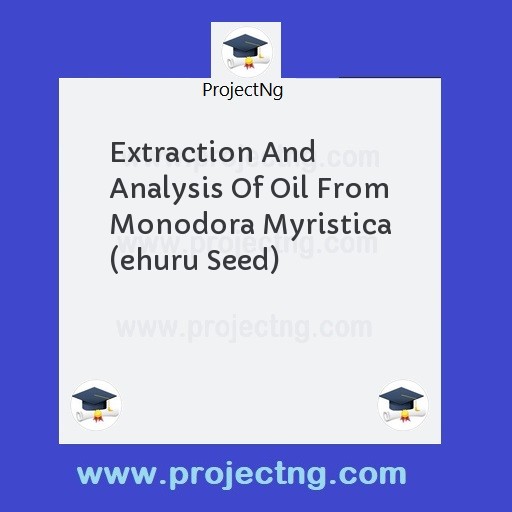Extraction And Analysis Of Oil From Monodora Myristica (ehuru Seed)
Science Lab Technology Project Topics
Get the Complete Project Materials Now! »
EXTRACTION AND ANALYSIS OF OIL FROM MONODORA MYRISTICA (EHURU SEED)
ABSTRACT
Extraction and analysis of Monodora myristica (ehuru) oil was investigated, the result of the proximate analysis carried out on the seed reveals the presence of moisture, crude protein, crude fat, ash, crude fibre, and carbohydrate in the sample. The moisture, protein, fat, ash, crude fibre and carbohydrate content of Monodora myristica was found to be 4.0%, 11.9%, 11.3%, 4.6%, 8.7% and 42.5% respectively, fatty acid analysis of the oil revealed that Monodora myristica has the following fatty acid with the concentrations. Capric acid (0.36%), Palmitoleic acid (0.42%), Lauric acid (1.16%), myristic acid (0.63%) stearic acid (3.42%), Linolenic acid (39.81%), Linoleic acid (44.6%), capriclic acid (0.52%) and -linolenic acid (2.37%). The result inferred that if, consumed in sufficient amounts, the spices could contribute towards meeting human nutritional requirements for normal growth and adequate protection against disease arising from malnutrition.
CHAPTER ONE
1.0 INTRODUCTION
Calabash nutmeg, Monodora myristica (Ehuru) is a tropical tree of the family Annonaceae or custard apple family of flowering plants. Other names of nutmeg include Jamaica nutmeg, African nutmeg, ehuru, ariwo, awerewa, ehiri, African orchid nutmeg. The calabash nutmeg tree grows naturally in evergreen forest from Liberia to Nigeria and Cameroon, Angola and also Uganda and West Kenya. Due to the slave trade in the 18th century, the tree was introduced to the Caribbean Island where it was established and become known as Jamaican nutmeg.
In 1897, the Monodora myristica was introduced to Bogor Botanical Gardebn, indonesia, where the trees flower on a regular basis but no fruit could yet be collected. Due to its large and orchid-like flowers, the tree is also grown as an ornamental and other food materials (Fournier et al, 1999).
The Monodora myristica tree can reach a height of 35m and 2m in diameter at breast height. It has a clear trunk and branches horizontally. The leaves are alternately arranged and drooping with the leaf blade being elliptical, oblory or broadcast towards the apex and tapering to the stalk. They are petiolate and can reach a size of up to 45 x 20cm (Burkill, 1997).
The flower appears at the base of new shoots and is singular, pendant, large and fragrant. The pedicel bears a leaf-like bract and can reach 20cm in length. The flower sepals are red-spotted, crisped and 2.5cm long. The corolla is formed of six petal of while the three outer reach a length of 10cm and show curled and red, green and yellow spots. The three inner petals are almost triangular and form a white yellowish cone which on the outer-side is red-spotted and green on the inside. The flower’s stigmas become receptive before it’s stemens mature and shed their pollen (protogymous). The flower is pollinated by insects (Fournier et al, 1999).
The fruit is a berry of 20cm diameter and 18 smooth, green and speherical and becomes woody. It is attached to a long stalk which is made up to 60cm long. Inside the fruit the numerous oblongoid, pale brown, 1.5cm long seeds are surrounded by a whitish fragrant pulp. The seed contains 5 – 9% of a colourless essential oil (Joseph, 2007).
The odour and taste of the Monodora myristica seed is similar to nutmeg and it is used as a popular spice in the West African cuisine. The fruits are collected from wild trees and the seeds are dried and sold whole or ground to be used in stews, soups, cakes and deserts. For medicinal purposes they are used as stimulants, stomachic, for headaches, sores and also as insect repellant. The seeds are also made into necklaces (Weiss, 2002).
The timbers obtained form Monodora myristica is hard but easy to work with and is used for carpentry, house fittings and joinery. In medicine, the bark is used in treatments of stomach aches. Febrile pains , eye disease and haemorrhoids (Weiss, 2002).
The essential oil that can be obtained from the leaves contains β-caryophyllenc, -humulene and -pinene. The major compound found in the essential oil form the seed are -phellandrene, -pinene, myrcene, limonene and pinene (Burkil, 1997).
1.1 OBJECTIVE OF THE STUDY
The objective of this research work is to extract and analyze the oil form the seed of Monodora myristica (ehuru seed).
1.2 STATEMENT OF PROBLEM
Monodora myristica contains substantial ammonia of non-dryly oil and that has necessitated the need for a project work to be carried out on the extraction and analysis of oil form the seed of Monodora myristica.
1.3 SIGNIFICANCE OF THE STUDY
The result of this research work will out line the procedure for extraction and analysis of the oil from the seed of Monodora myristica.
1.4 LIMITATION OF THE STUDY
This research work is limited to the extraction of oil form Monodora myristica seed and the analysis of the oil. The major problem encountered in the project work is lack of finance and as a group it is not easy to come together when required.
Be the First to Share On Social

Enjoying our content?
Don't miss out on new videos! Subscribe to our YouTube channel for more awesome content.
Subscribe Now!













